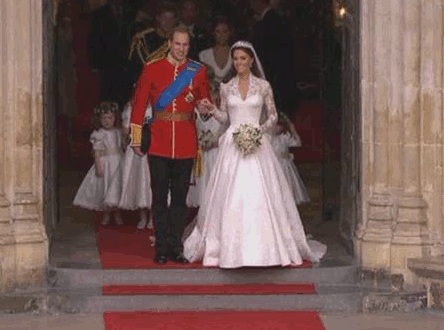
Catherine's Wedding Dress as she leaves Westminster Abbey with Prince William.
Photo courtesy of It's a Foot.
Catherine's wedding dress first came into view as she left the Goring Hotel with her father, Mike in the Rolls Royce 1. Even then, with only the top half of the dress in view as she journeyed in the car toward Westminster Abbey, it was imediately clear that this was a dress which was perfect for Catherine. The V-shaped neck with intricate lacework around the shoulders and arms gave a very elegantly stylish first impression, and the amazingly fine veil enabled everyone to see Catherine's joy on her way to her marriage ceremony.
A diamond tiara held the veil in place, with Catherine's hair gathered up at the front and curled softly at the back.
As she gracefully exited the Rolls Royce at Westminster Abbey, the world had its first full view of the wedding dress. It was at this point that it was revealed that the designer was Sarah Burton of the Alexander McQueen fashion house. Sadly, Lee Alexander McQueen himself committed suicide back in 2010, just over a year before the Royal wedding, and therefore prior to William and Catherine's engagement having even been announced. Sarah Burton had worked closely with Lee McQueen for 14 years and picked up the reins of the fashion house after his death.
Catherine took a close interest in Sarah Burton's design of the dress, which was made of Ivory and white satin gazar. This is a lightweight and loosely woven yet stiff silk with a crisp finish. Although the use of silk as a fabric dates back to around 5,000 years ago, gazar itself was first created as recently as 1958.
The ivory silk tulle veil was so fine that it gave an amazingly clear view of Catherine's face even with the veil down. It was held in place by a halo tiara made by Cartier in 1936 which was something borrowed from the Queen. The diamond tiara had originally belonged to the late Queen Mother, having been given to the Queen Mother by her husband, George, 3 weeks before he became King. The Queen mother had given the tiara to the current Queen Elizabeth on her 18th bithday.
In her strapless dress, Catherine kept her shoulders covered which is a traditonal requirement in Royal Weddings, yet the lace on the shoulders gave quite a transparent look. The dress came in to the waist then out as a full skirt. At the back of the gown were fifty-eight buttons covered with gazar and organza. With its pleats and arches the gown was designed to look like the opening of a flower, a perfect symbol for this bud of a princess who will flower into future Queen of England. Behind the dress, the Train was 2.7 metres long (9 feet) which is relatively short for a Royal bride. Princess Diana's train, for example, had been 25 feet long when Prince William's mother had married Prince Charles at St Pauls Cathedral.
The French chantilly lace, which was hand-made by the Royal Scool of Needlework at Hampton Court Palace, incorporated the rose, thistle,daffodil and shamrock. Even the embroiderers who worked on the dress did not know who would be wearing it. English Cluny lace was also used, including on the underskirt which combined the lace with silk tulle.
The lengths of thread used in creating the dress were 30 centimetres long to keep them clean. The stitches were two to three milimetres apart and the needles used were very fine number 12 embroidery needles which were changed every 3 hours to ensure maximum sharpness. Workers involved in putting the lace mofits on the bottom of the skirt had to wash their hands every 30 minutes whilst they were stiching the lace on, in order to keep the lace perfecly clean.
Elizabeth Emmanuel, designer of Princess Diana's dress for her 1981 wedding explained that the Irish lacemaking technique, which had also been used in Diana's dress, means that if you look at the dress in detail you'll notice thatthere are no seams because al of the lace was specially created in the shape of the dress,which is very difficult to do.
Catherine's earrrings were a gift given by her parents especially for the wedding day. Adding to the unspoken theme of nature which the wedding seemed to convey, the earrings were diamond-set stylized oak leaves, with a diamond set drop in the shape of a pear. Suspended in the centre was a pavé set diamond acorn. Made by Robinson-Pelham, the earrings perfectly complimented the tiara, and echoed the Middleton family's coat of arms which includes oak leaves and acorns.
As well as having created Catherine's wedding dress, the Alexander McQueen fashion house also hand-made the shoes she wore for the big day. Although the only brief glimpse most of us had of the shoes were as Catherine stepped out of Rolls Royce number One, it could be seen that the shoes were pure whilte, with a modest high-heel. They were made of ivory duchesse satin (very apt for the newly-titled Duchess of Cambridge) with lace which was hand-embroidered by the Royal School of Needlework.
Altogether the dress and accessories had an understated yet finely detailed and very elegantly feminine effect. Perfect for Catherine, our modern and very stylish Royal bride.
- Login to post comments